Israel at war: What happened on Day 38?
1,200 Israelis murdered since October 7, including 363 soldiers • 239 held hostage by Hamas, four hostages released, one rescued
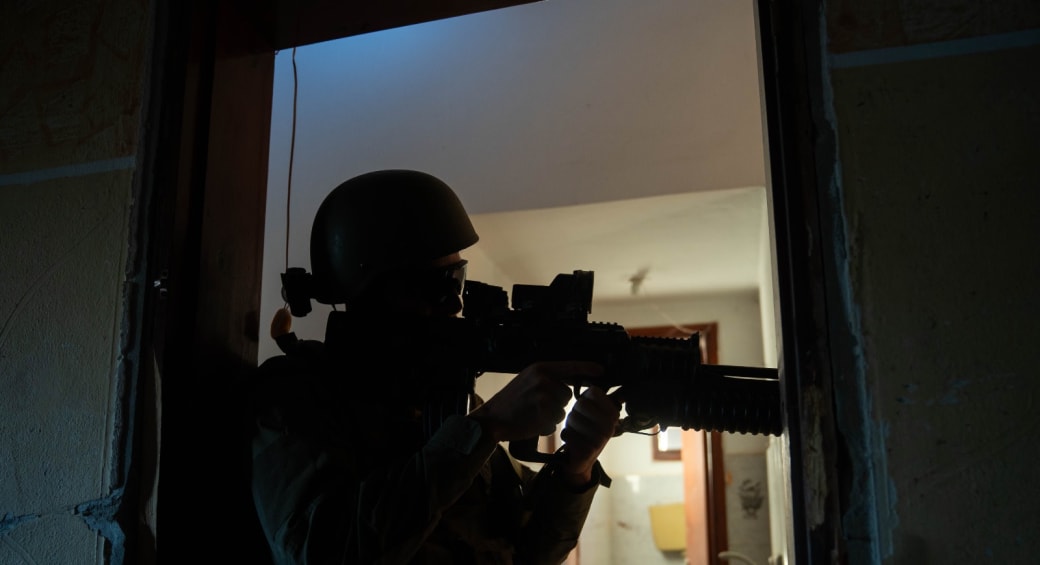

Read our latest live blog for Day 40 of the Swords of Iron War

IDF reveals Hamas hostage, explosive center under Rantisi Hospital
There were baby bottles found on the site, suggesting Israeli hostages had been held there.

IDF Chief Spokesman Brig. Gen. Daniel Hagari revealed late Monday night an underground Hamas command center under the Rantisi Hospital which not only contained suicide vests, rocket-propelled grenades, and a variety of weapons but also signs, such as baby bottles, that Hamas had held Israeli hostages there.
He said there was evidence and independent separate intelligence that Hamas terrorists had returned directly to the hospital after their attacks and mass murders of Israelis on October 7.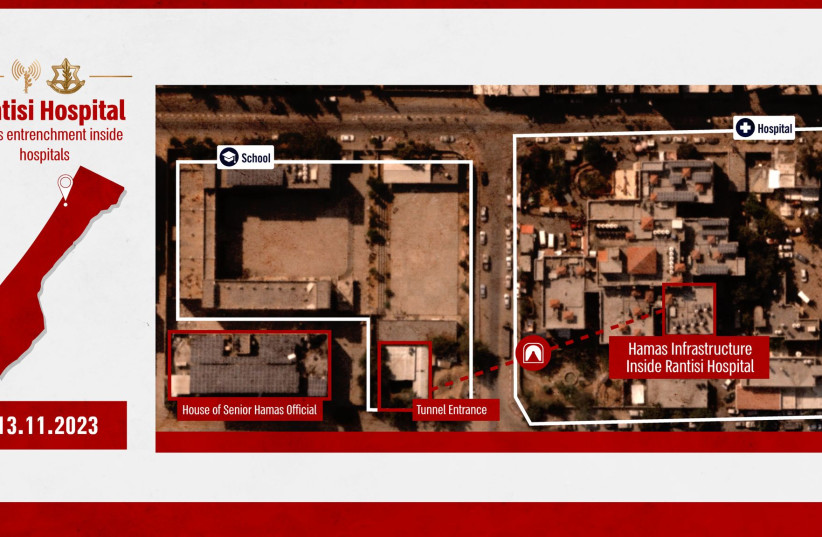
Next, he noted that an IDF robot found additional terror tunnels, including electricity being siphoned off from the hospital for use by the terrorists underground.
A video showed the basement of the hospital which showed a location disconnected from the rest of the hospital where the significant terror explosives and armaments were kept.
Hagari showed a motorcycle with a bullet hole inside it and items connected to one of the hostages in the vicinity of the motorcycle.
One of the chairs showed ropes and other items indicating that a hostage had been held there.
A baby bottle and other baby materials were found which the IDF said were connected to a hostage baby.
There were also improvised toilets, which Hagari said was infrastructure to hold hostages.
A list on a board marked the days since October 7, possibly indicating when the terrorists left, likely with hostages.
He said he was not sure if the terrorists used the evacuation to escape or used additional networks of underground tunnels.
Go to the full article >>White House: Israel does not seek firefights in Gazan hospitals

The White House said on Monday that Israel shares the Biden administration's view that firefights should not take place in hospitals in Gaza.
US President Joe Biden's national security adviser Jake Sullivan said the Israeli government has also said they are prepared to provide fuel to hospitals to ensure they can continue to operate.
Go to the full article >>Hamas discussed releasing 70 hostages in return for 5-day truce

Hamas members said on Monday they told Qatari mediators the group is ready to release up to 70 women and children held in Gaza in return for a five-day truce.
"The truce should include a complete ceasefire and allowing aid and humanitarian relief everywhere in the Gaza Strip," Abu Ubaida, the spokesman for the Al-Qassam Brigades, said in a recorded audio published on the group's Telegram channel.
He went on to accuse Israel of "procrastinating and evading" the price of the deal.
Go to the full article >>IDF soldiers share photo in conquered Hamas parliament
In the moving picture, the team of fighters can be seen proudly waving Israeli flags in the terrorist organization's legislative council building
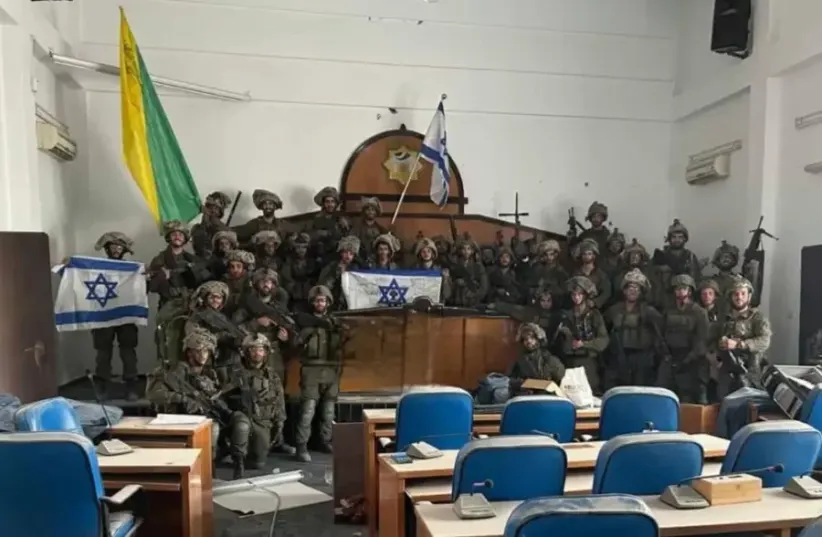
IDF soldiers of the Golani Brigade shared a historic photo on Monday showing the Israeli flag inside the Hamas parliament building in Gaza.
In the moving picture, the team of fighters can be seen proudly waving Israeli flags in the terrorist organization's legislative council building
"Hamas has lost control of Gaza - terrorists are fleeing south, civilians are looting Hamas bases," Defense Minister Yoav Gallant stated on Monday.
After completing a situational assessment in which he emphasized the progress of IDF soldiers in fighting in Gaza.
"The IDF forces work according to a plan and carry out the missions with precision, lethality and in coordination between the air, sea and land forces, using precise intelligence," the defense minister said.
"There is no power that Hamas has capable of stopping the IDF. The IDF is advancing to every point. Hamas has lost control of Gaza, terrorists are fleeing south, civilians are looting Hamas bases, they have no confidence in the government."
IDF breaks Hamas's effectiveness
IDF attacks have broken the effectiveness of 10 out of 24 Hamas battalions, says the military.
For the first time since the start of the war, the IDF on Monday provided its official estimates of the size and make-up of what Hamas's forces were on the eve of the war which started on October 7.
In addition, the IDF gave its estimate of the impact it has had on Hamas's forces through around five weeks of air strikes and two-and-a-half weeks of a ground invasion.
According to the IDF, Hamas started the war with 30,000 men who were split into five regional brigades, which themselves split into 24 battalions, which themselves split into 140 companies. Each battalion had around 1,000 plus men.
Troops from the IDF's 188th Brigade eliminated a terrorist squad operating in the area of the Al-Quds hospital in Gaza City, an IDF statement said on Monday, after an anti-tank missile was shot at IDF soldiers, damaging an Israeli tank.
Several terrorists hidden among civilians fired two RPG launchers at IDF soldiers in front of the hospital, the statement said. The combat brigade, which included armor, engineering, and infantry forces, responded with live fire and shelling, with air support. About 21 terrorists were killed, the IDF said, with no Israeli casualties.
What can we take away from The Washington Post's Hamas article?
Those are the two main takeaways from a Washington Post piece Sunday about what Hamas hoped to accomplish on October 7, and how the terrorist organization was able to lull Israel to sleep.
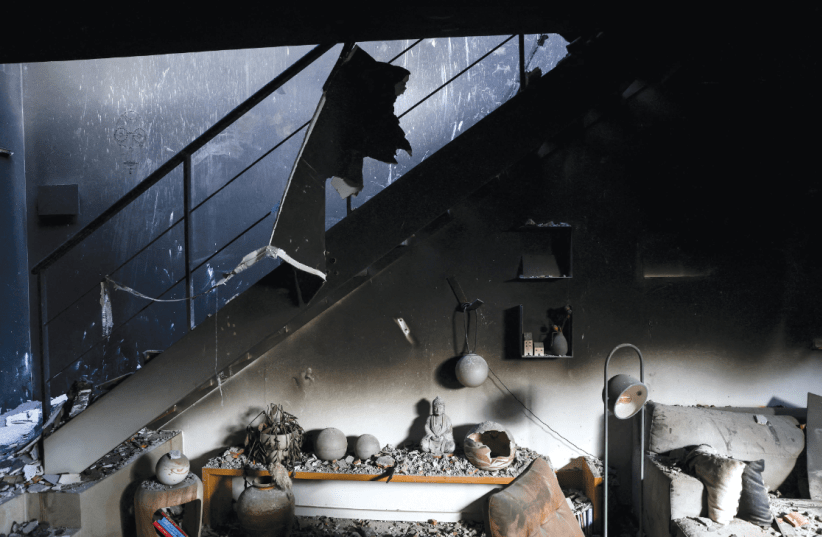
It could have been worse, and we really messed up.
Those are the two main takeaways from a Washington Post piece Sunday about what Hamas hoped to accomplish on October 7, and how the terrorist organization was able to lull Israel to sleep and deceive it.
First, regarding how it could have been worse.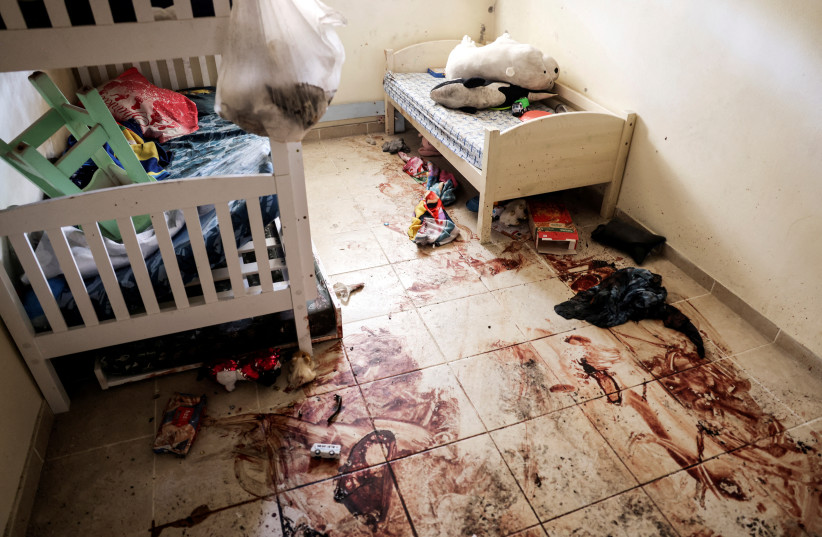
Despite various reports that Hamas was surprised by its “success” – murdering 1,200 people, raping, kidnapping 240 men, women and children, including babies and the elderly, and burning and ransacking like 5th-century Huns – the Post report said that Hamas actually intended to push much farther into Israel.
According to the report, based on current and former intelligence and security officials from Western and Mideast countries, Hamas had hoped to push into large Israeli cities and even to the West Bank. Although the report did not say where Hamas hoped to attack in Judea and Samaria, the southern Hebron Hills settlement of Sansana is just some 30 km. east of Ofakim – which itself is some 25 km. from Gaza, and the furthest point east where the terrorists penetrated.
Had Hamas pushed that far, they also would have gone through or near to a number of other communities, such as Lehavim and Meitar.
How ironic that once there was serious talk about linking Gaza to the West Bank via a safe passage that would have run a similar route.
“New evidence suggests that they were prepared to go even further," the Post report read. “Some militants carried enough food, ammunition, and equipment to last several days, officials said, and bore instructions to continue deeper into Israel if the first wave of attacks succeeded, potentially striking larger Israeli cities.”
According to the report, one terrorist unit carried reconnaissance information and maps suggesting an intention to continue the assault up to the border of the West Bank. “Hamas had been increasing its outreach to West Bank militants in recent months, although the group says it did not notify its West Bank allies of its October 7 plans in advance.”
According to a senior Israeli official quoted in the story, “They planned a second phase, including in major Israeli cities and military bases.” The paper quoted a former US official saying that had Hamas reached the West Bank, “it would have been a huge propaganda win – a symbolic blow not only against Israel but also against the Palestinian Authority.”
This report dedicated two paragraphs to descriptions about the atrocities Hamas committed. In the original version of the story online, a third paragraph appeared quoting Defense Minister Yoav Gallant as saying, “We know from interrogations that Hamas came in with detailed plans of their attack, including which commander should rape which soldiers in different places.”
That paragraph, however, was later edited out of the story.
According to the story, Hamas did not only want to murder, rape, and pillage. Rather, its ultimate goal was to provoke an Israeli response – one they knew would cause heavy casualties in Gaza – to trigger a major regional war.
In this way, according to one expert cited in the story, they took a page out of Al-Qaeda leader Osama Bin Laden’s playbook, since Bin Laden’s expectation was that the 9/11 attacks would lead to a fierce US response that would trigger a violent confrontation between the Muslim world and the West.
Citing current and former intelligence officials and counterterrorism experts, the report said, “Hamas expected an Israeli response and was willing to accept such sacrifices as the price for kick-starting a new wave of violent Palestinian resistance in the region and scuttling efforts at normalizing relations between Israel and Arab states.”
So, as horrific as the events of October 7 were, Hamas had hoped – and had planned – for far worse.
How did Israel mess up?
Now regarding how Israel messed up.
The story paints a picture of Hamas conducting above and below-ground military exercises while planning the attack for more than a year.
The terrorists trained and collected intelligence on their targets by using “cheap surveillance drones to generate maps” and Palestinian workers allowed into Israel to work, “often in the same farming communities that were in Hamas’s crosshairs.” Though not sophisticated, the paper wrote, the intelligence gathering was methodical and thorough.
The precise plans for the attack were restricted to a tiny cadre of military leaders. The Post took at face value Iranian and Hezbollah claims that they did not have advance knowledge of the attack.
And then there was the deception. The story retells how Hamas lulled Israel to sleep, hinting at newfound moderation and pragmatism – something Israel desperately wanted to believe.
“To buttress that perception of moderation, clashes between Hamas and Israel ceased after 2021. The group notably refrained from jumping in on several occasions when its Gaza ally, Palestinian Islamic Jihad, or PIJ, fired rockets or engaged militarily with Israel. To many in Israel, it was further evidence that Hamas had changed and no longer sought a bloody conflict. Some reports suggested that Hamas officials even passed along intelligence about PIJ to the Israelis to reinforce the impression that they were being cooperative.”
And then, of course, Israel was off focus. It concentrated on an upsurge of violence in Judea and Samaria and was concerned with a flare-up in the north, as well as being preoccupied with the whole judicial reform.
“The distractions and ruses worked. In Gaza, less than 50 miles from the West Bank, the arming and training of Hamas assault teams were largely ignored or dismissed,” the report continued.
Since the war began following the massacres on October 7, Israel has rightfully been focused more on fighting the war and destroying Hamas than on trying to figure out what went wrong and where it failed. Once the war is over, those questions will dominate the national agenda.
The Post story gave a general outline of what happened. Answers to the question of how it happened – how Israel allowed it to happen – will be taken up by the various military and political committees and commissions that will be set up soon after the war ends.
Israel FM: Israel has a diplomatic clock of only 2-3 weeks for Gaza war
“From a diplomatic point of view, we recognize that pressure has begun to bear on Israel. The pressure is not very high [now], but it is increasing,” Cohen said.

Israel has a diplomatic clock of only two to three weeks to conduct its war to oust Hamas from Gaza, Foreign Minister Eli Cohen told reporters in Jerusalem on Monday as international calls for a ceasefire have grown.
“From a diplomatic point of view, we recognize that pressure has begun to bear on Israel. The pressure is not very high [now], but it is increasing,” Cohen said.
When asked how long a diplomatic clock he believed Israel had, he answered “two to three weeks.” Cohen stated, "From our point of view there is no clock — we won't stop the military campaign until we've eliminated Hamas and returned the hostages."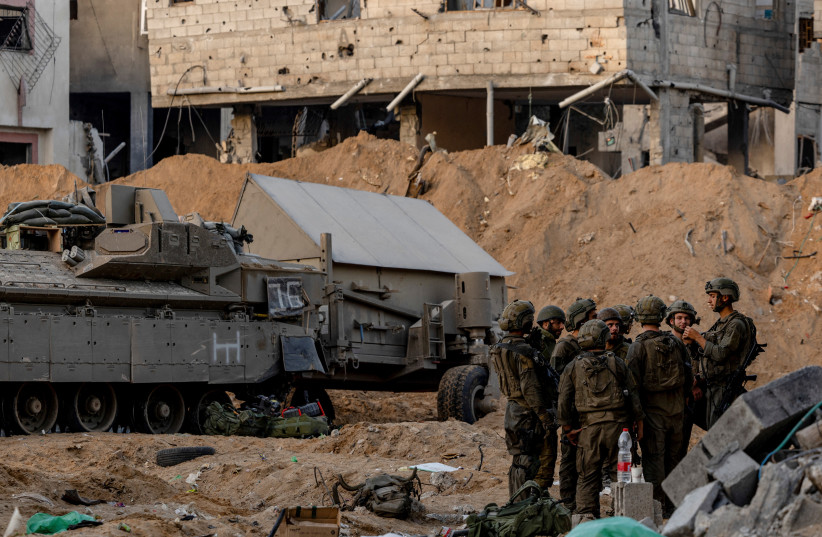
Cohen noted that some eight countries had taken steps against Israel as a result of the war, including in some cases pulling their ambassadors and in others cutting ties altogether.
Those countries included: Bolivia, Chad, Chile, Columbia, Honduras, Jordan, South Africa, and Turkey.
“We are working to sway two to three countries to return their ambassadors in the coming days or weeks,” Cohen said, but he did not specify which ones.
“Pressure on other countries to withdraw their ambassador to sever relations will increase particularly since the military campaign is not in its final stages,” Cohen stated.
There are some 13 to 14 swing countries, which Israel fears, could also take significant diplomatic steps against the Jewish state, he explained.
“We are in close contact with those countries in order to prevent damage to our relations with them,” he said.
Military campaign 'legitimate'
The Foreign Ministry has worked since the start of the war, Cohen explained, to make Israel’s case to the global community that its military campaign in Gaza is a legitimate response to the October 7 attack. On that day, Hamas infiltrated southern Israel, killing over 1,200 people and seizing more than 239 people captive.
“The captives are one of the main issues that give Israel legitimacy to continue fighting” and to rebuff international calls for a ceasefire, he said.
“The world accepts that Israel will not stop [its military campaign in Gaza] until all the captives are released,” he added.
The seizure of such a high number of hostages from one event has never occurred in Israel and is highly unusual on the international stage, he said.
Cohen said he brings family members of the captives to every meeting he holds with foreign ministers and representatives of international institutions both in Israel and abroad.
He explained that he brought them to the European Union in Brussels and to the United Nations in New York. Representatives from the hostages will also accompany him to Geneva on Tuesday, where he plans to meet with the head of the International Committee of the Red Cross to press the organization to meet with the hostages.
Go to the full article >>IDF eliminates senior Hamas officials in Gaza
Air strike kills Hamas's former director of military intelligence, who orchestrated Atzmona terror attack in 2002
IDF and Israel Security Service (Shin Bet) forces eliminated the head of Hamas's anti-tank system in the Khan Yunis Brigade, as well as the organization's former director of military intelligence, the security services announced in a joint statement Monday.
Yaakub A'ashur, head of the anti-tank system in Hamas's Khan Yunis Brigade, was eliminated by an IDF aerial strike under the direction of the Shin Bet, the statement said. A'ashur was a battalion commander and later the head of the anti-tank formation in the Khan Yunis Brigade. As part of his role, he took part in leading and directing offensive lines against IDF forces.
Forces also eliminated Mohammed Khamis Dababash, a senior Hamas terrorist who had previously served as the organization's director of military intelligence, among other roles.
Over the last two years, Dababash served as secretary of the national relations portfolio in Hamas' political bureau. He also served as Hamas' representative at the gathering of the national and Islamic factions in the Gaza Strip. He was involved in the planning of the attack in the settlement of Atzmona in March 2002, in which five Israelis were murdered.
Other Hamas officials eliminated
Security forces also eliminated Tahsin Maslam, Hamas' commander of the combat assistance company, who oversaw special forces in Beit Lahia; Jahad Azzam, a military intelligence officer in Zeitun, and Manir Harev, a senior official in the Rafah Brigade.
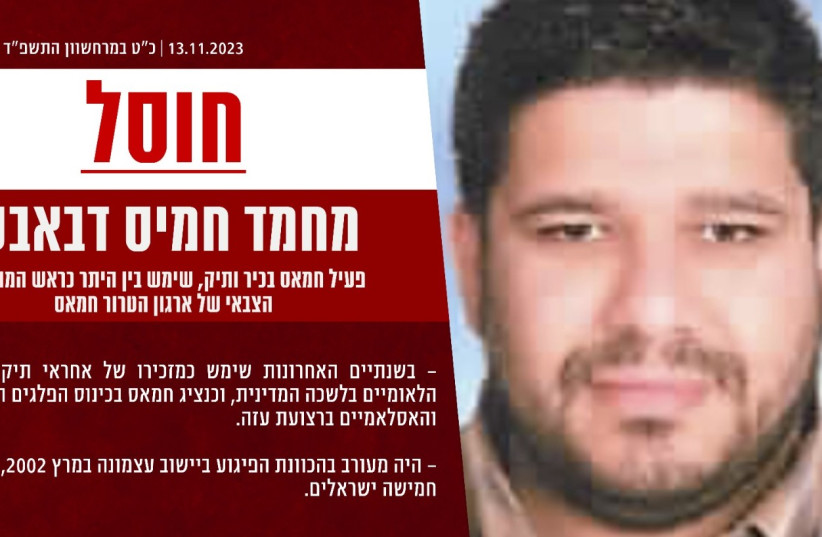 The IDF and Shin Bet announced that they had eliminated Mahmoud Hamis Dababesh, Hamas' former director of military intelligence, on November 13, 2023. (credit: IDF SPOKESPERSON'S UNIT)
The IDF and Shin Bet announced that they had eliminated Mahmoud Hamis Dababesh, Hamas' former director of military intelligence, on November 13, 2023. (credit: IDF SPOKESPERSON'S UNIT)The IDF says it has struck over 4,300 terrorist targets, including some 300 terrorist tunnel shafts, since it began its invasion of Gaza in response to the October 7 attacks.
Go to the full article >>IDF attacks have broken effectiveness of 10 of 24 Hamas battalions
Military gives 1st official estimate of Hamas’s total forces since start of war.

IDF attacks have broken the effectiveness of 10 out of 24 Hamas battalions, says the military.
For the first time since the start of the war, the IDF on Monday provided its official estimates of the size and make-up of what Hamas's forces were on the eve of the war which started on October 7.
In addition, the IDF gave its estimate of the impact it has had on Hamas's forces through around five weeks of air strikes and two-and-a-half weeks of a ground invasion.
According to the IDF, Hamas started the war with 30,000 men who were split into five regional brigades, which themselves split into 24 battalions, which themselves split into 140 companies. Each battalion had around 1,000 plus men.
Prior unofficial estimates had set Hamas's forces as between 15,000 to 40,000.
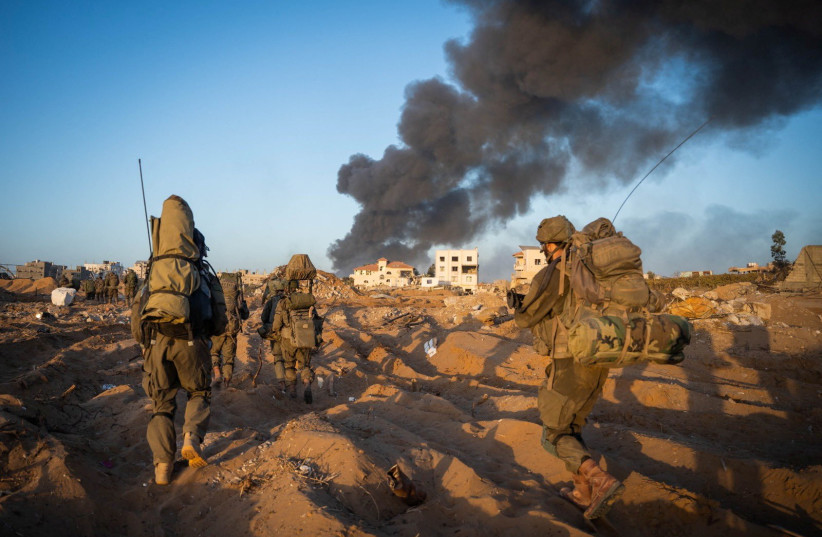
Hamas and Islamic Jihad's dwindling numbers
Further, prior unofficial estimates before the conflict with Islamic Jihad in May of this year had set its forces at around 10,000.
IDF sources indicated that on the eve of the war, Islamic Jihad forces had shrunk somewhat from the 10,000 number, possibly due to losses this past May.
Each Hamas brigade is divided into specific skill sets, including those who specialize in: firing anti-tank missiles, sharpshooters, engineers, aerial units (drones or motorized hang gliders, but no aircraft), naval units, and maneuvering battle units.
In addition, each battalion has regional command centers and more local smaller-scale positions which are the focal point of directing the battalion's operations.
Two examples that the IDF gave of Hamas battalions whose effectiveness has been harmed were the Shaati and the al Daraj-Tuffah battalions.
According to the IDF, the Shaati battalion lost 200 men, including many battalion and company commanders as well as most of its battalion-level and lower-level command centers and positions.
IDF sources said that in the time between initial IDF fighting with the Shaati battalion until several days later, there was a notable change and loss of effectiveness.
Sources said that at first, there was a clearly synchronized battle plan by Hamas to ambush Israeli forces, using a variety of tactics and specialized units.
However, once several Hamas commanders were killed by the IDF, the coordination broke down, and the various companies ceased to operate in unison, sometimes even only very small groups of Hamas forces working together, with no awareness or connection to other Hamas forces' efforts.
In addition, IDF sources said that even when some battalions tried to replace lost commanders with commanders from other battalions, the loss of familiarity and expectations showed and the battalion did not return to their former effectiveness levels.
This has been crucial for the Shaati battalion because it is responsible for the ShifaHospital area where Hamas's top headquarters is situated,
A similar story came from the IDF regarding the al Daraj-Tuffah battalion, which has lost over 260 men, and commanders at all levels.
All of the above are the first in-depth data the IDF has given about its progress, other than that it has killed several thousand Hamas forces to date.
However, multiple top IDF sources have expressed doubt about Hamas being close to "breaking" even as publicly top political and IDF officials say it has lost control of northern Gaza.
Go to the full article >>IDF soldiers kill 21 terrorists in Al-Quds Hospital in Gaza City
IDF in Gaza: Weapons found in children's bedroom, university • Israeli military strikes over 300 tunnel shafts, thousands of Hamas installations
Troops from the IDF's 188th Brigade eliminated a terrorist squad operating in the area of the Al-Quds hospital in Gaza City, an IDF statement said on Monday, after an anti-tank missile was shot at IDF soldiers, damaging an Israeli tank.
Several terrorists hidden among civilians fired two RPG launchers at IDF soldiers in front of the hospital, the statement said. The combat brigade, which included armor, engineering, and infantry forces, responded with live fire and shelling, with air support. About 21 terrorists were killed, the IDF said, with no Israeli casualties.
A video of the battle released by the IDF shows civilians leaving the hospital building, as well as other terrorists emerging from adjacent buildings to hide among the civilians and join in the attack, per the statement.
The IDF says it has struck over 4,300 terrorist targets, including some 300 terrorist tunnel shafts, since it began its counter-invasion of Gaza.
Hundreds of Hamas anti-tank launchers have been destroyed during IDF operations, as well as close to 3,000 terrorist installations, including hundreds of boobytrapped weapon storage facilities, operational headquarters, and control-and-command centers across Gaza, according to the Israeli military.
Weapons cache found in child's bedroom of senior PIJ official
Israeli forces uncovered a weapons cache hidden in a child's bedroom in the home of a senior Palestinian Islamic Jihad official in Gaza, the IDF said on Monday morning.
The hidden arsenal was discovered in a raid carried out by reservists from the IDF's 551st Brigade, which lost four of its fighters during fighting in Gaza. The brigade also located a tunnel shaft in a civilian area of Beit Hanun, which contained various weaponry and intelligence gathered by Gazan terrorist groups.
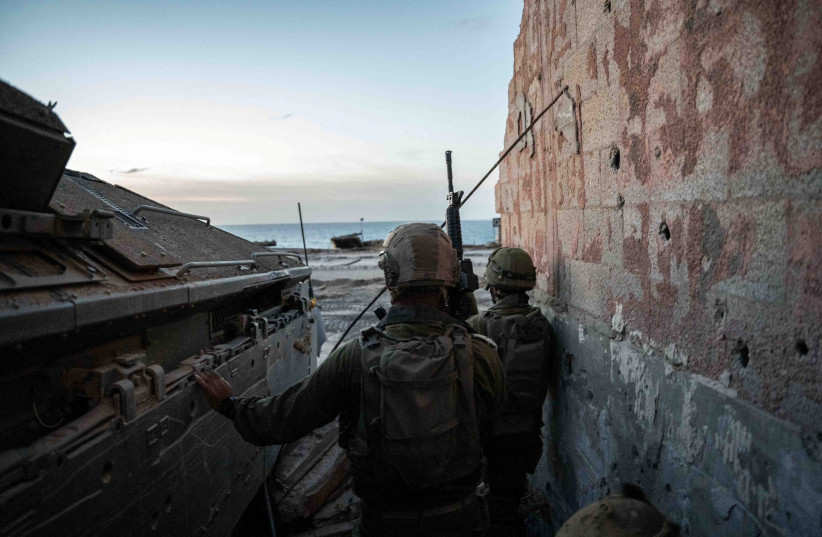
Elsewhere in Gaza, forces from the IDF's 401st Brigade uncovered Hamas terrorist infrastructure inside civilian centers in the al-Shati camp in northern Gaza.
The forces found and confiscated dozens of weaponry and other combat equipment, as well as Hamas intelligence, including operative plans.
Go to the full article >>Israel-Hamas War: What you need to know
- Hamas launched a barrage of rockets on October 7, with thousands of terrorists infiltrating from the Gaza border
- Over 1,200 Israelis and foreign nationals were murdered as of Tuesday afternoon, and more than 5,431 were wounded according to the Health Ministry
- IDF: 239 families of Israeli captives in Gaza have been contacted, 30 of them children
